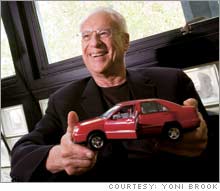|
Bring on the cars from China
Malcolm Bricklin, who brought you the Yugo and the Subaru, is betting that cars from China will rock the U.S.A.
(FORTUNE Magazine) - Malcolm Bricklin, legendary serial entrepreneur, is starring in the movie of his life. He can scarcely brush his teeth without being followed by a videocamera. So far, more than 1,000 hours of tape documenting Bricklin's latest adventure - trying to become the first person to bring Chinese automobiles into the U.S. - have been shot and catalogued.
The footage shows Bricklin browbeating subordinates, issuing ultimatums, and storming out of meetings. Bricklin's son Jonathan, who is directing the video project, says, "My value is to document that he [Bricklin] is not a lunatic." It isn't clear that he is succeeding. Nobody else can prove that Bricklin isn't a lunatic either. Now 67, he has built a career doing things that other people consider madness. Some have proved to be triumphs (launching Subaru (Research) in the U.S.), and some failures (the Bricklin sports car; the Yugo). His combination of charm, manic energy, and over-the-top enthusiasm turns off as many as it enchants. To some he is at best a promoter and at worst a charlatan. Will Bricklin's China venture be the triumph that proves critics wrong? His business instincts seem solid, though there are signs of trouble. China is certain to enter the U.S. with cars, and some 18 months after he first announced his plan, Bricklin is still standing. Plans for the future
His strategy: Import car and SUV models - five are planned - from Chery, China's largest independent automaker, and sell them via a network of some 125 dealers. His pitch: Get $30,000 worth of features like premium interiors for $19,000 - an Audi for the price of a Subaru. He persuaded Atlantic Pacific Capital to help raise $200 million. Says CEO Jim Manley: "Malcolm has had some fits and starts over his lifetime, but I was impressed that he has imported more different kinds of cars over 30 years than anybody else." Signing up U.S. dealers has been more complicated, and Bricklin has reworked his plan. At first, he demanded each dealer put up at least $10 million, with a big chunk going toward a grandiose showroom with giant movie screens and a half-mile test track. "That lasted about 12 minutes," Bricklin says. His plan now: Dealers invest $2 million in his company and use vacant showrooms. Bricklin says he has persuaded 50 dealers (with 40 "in the pipeline") to make a down payment. He originally intended to get the first Chery cars to dealers by early 2007 and sell 250,000 cars the first year, but now says the first model - a crossover SUV - won't arrive until the end of '07 at the earliest. He blames the delay on a powertrain upgrade: He had planned to offer a 3.0-liter V-6 engine with a four-speed automatic transmission but realized it wouldn't appeal to the kind of customer he hopes to attract; he asked Chery to develop a 3.6-liter V-6 with a six-speed instead. "That extra two gears and six-tenths of a liter are a bitch," he says. The China venture is likely to be Bricklin's last, and he plans to go out big. He's installed his company, modestly named Visionary Vehicles, in a $40,000-a-month, 8,000-square-foot Tribeca loft. Typically dressed like one of the Blues Brothers, in a black T-shirt, black jacket, and black jeans, he roams the space like a lion, creating chaos wherever he goes. The frenzy is entertaining for Bricklin, and his subordinates seem to accept it with amused resignation. "He's a big child," says Jonathan. Bailing out
It is a style that has been the same for decades as Bricklin has careened from venture to misadventure. A college dropout, he made a fortune selling hardware-store franchises. A foray into motor scooters led to a 1968 deal to import Subaru minicars. The cars sold well until Consumer Reports declared them unsafe; Bricklin bailed out in 1972. Following in the tradition of Henry J. Kaiser and Preston Tucker, Bricklin decided to build his own car. With his $120 million Subaru windfall, he opened a factory in Canada to build the Bricklin SV-1, an acrylic-bodied sports car with butterfly doors that sold for $9,000. Designed as a "safety car," the Bricklin was something of a stylish tank. Instead of selling 1,000 cars a month, Bricklin closed the factory within a year and declared personal bankruptcy. A decade passed before Bricklin got back into the car business in a serious way, this time as the importer of the Yugo, a tiny hatchback notable for its low price and its atrocious quality. Bricklin bolted in 1988 - this time collecting $20 million - leaving angry dealers and unhappy customers. Moving forward
Ventures with fuel cells and electric bicycles followed, but Bricklin didn't get another big idea until 2002, when Serbia tried to get him to resurrect the Yugo. While searching for facilities in other low-wage countries, he washed up in Wuhu, China, in 2004 for talks with Chery, a small but ambitious auto company owned by the provincial government. At the time Chery, now the No. 3 automaker in China, was best known for building a subcompact called the QQ that mimicked a small Chevy called the Spark. Chery's domestic success aside, Bricklin is going to need some big time help as he moves forward. But he isn't waiting. Next on his to-do list is finding 150 people to staff an engineering and design center in Detroit to validate the new cars. And he wants Chery to produce a hybrid gas-electric powertrain that will provide a better combination of speed and mileage than Toyota, Mercedes, or any other automaker.
"This is the most fun I've ever had," says Bricklin. "This is an aphrodisiac." Still to be determined: Will Bricklin's investors, dealers, and customers share the same pleasure? |
|

